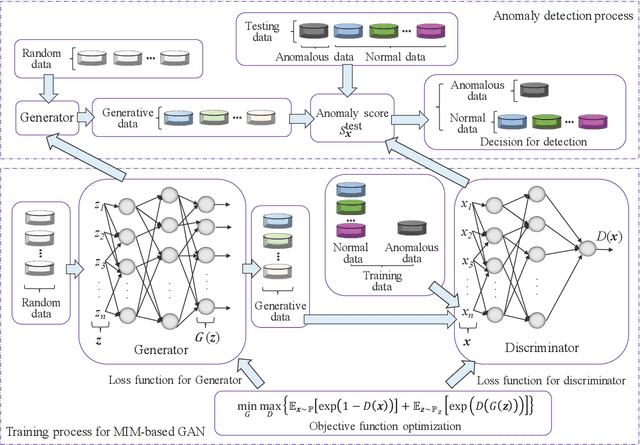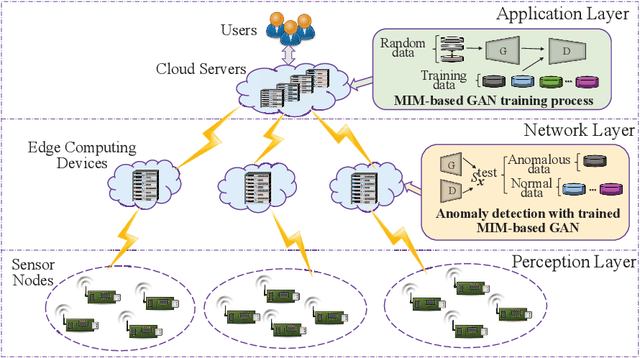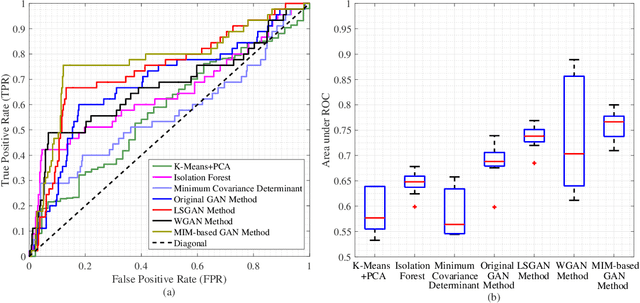gan-based anomaly detection
Papers and Code
GAN-based synthetic FDG PET images from T1 brain MRI can serve to improve performance of deep unsupervised anomaly detection models
May 12, 2025Background and Objective. Research in the cross-modal medical image translation domain has been very productive over the past few years in tackling the scarce availability of large curated multimodality datasets with the promising performance of GAN-based architectures. However, only a few of these studies assessed task-based related performance of these synthetic data, especially for the training of deep models. Method. We design and compare different GAN-based frameworks for generating synthetic brain [18F]fluorodeoxyglucose (FDG) PET images from T1 weighted MRI data. We first perform standard qualitative and quantitative visual quality evaluation. Then, we explore further impact of using these fake PET data in the training of a deep unsupervised anomaly detection (UAD) model designed to detect subtle epilepsy lesions in T1 MRI and FDG PET images. We introduce novel diagnostic task-oriented quality metrics of the synthetic FDG PET data tailored to our unsupervised detection task, then use these fake data to train a use case UAD model combining a deep representation learning based on siamese autoencoders with a OC-SVM density support estimation model. This model is trained on normal subjects only and allows the detection of any variation from the pattern of the normal population. We compare the detection performance of models trained on 35 paired real MR T1 of normal subjects paired either on 35 true PET images or on 35 synthetic PET images generated from the best performing generative models. Performance analysis is conducted on 17 exams of epilepsy patients undergoing surgery. Results. The best performing GAN-based models allow generating realistic fake PET images of control subject with SSIM and PSNR values around 0.9 and 23.8, respectively and in distribution (ID) with regard to the true control dataset. The best UAD model trained on these synthetic normative PET data allows reaching 74% sensitivity. Conclusion. Our results confirm that GAN-based models are the best suited for MR T1 to FDG PET translation, outperforming transformer or diffusion models. We also demonstrate the diagnostic value of these synthetic data for the training of UAD models and evaluation on clinical exams of epilepsy patients. Our code and the normative image dataset are available.
AnomalyHybrid: A Domain-agnostic Generative Framework for General Anomaly Detection
Apr 06, 2025Anomaly generation is an effective way to mitigate data scarcity for anomaly detection task. Most existing works shine at industrial anomaly generation with multiple specialists or large generative models, rarely generalizing to anomalies in other applications. In this paper, we present AnomalyHybrid, a domain-agnostic framework designed to generate authentic and diverse anomalies simply by combining the reference and target images. AnomalyHybrid is a Generative Adversarial Network(GAN)-based framework having two decoders that integrate the appearance of reference image into the depth and edge structures of target image respectively. With the help of depth decoders, AnomalyHybrid achieves authentic generation especially for the anomalies with depth values changing, such a s protrusion and dent. More, it relaxes the fine granularity structural control of the edge decoder and brings more diversity. Without using annotations, AnomalyHybrid is easily trained with sets of color, depth and edge of same images having different augmentations. Extensive experiments carried on HeliconiusButterfly, MVTecAD and MVTec3D datasets demonstrate that AnomalyHybrid surpasses the GAN-based state-of-the-art on anomaly generation and its downstream anomaly classification, detection and segmentation tasks. On MVTecAD dataset, AnomalyHybrid achieves 2.06/0.32 IS/LPIPS for anomaly generation, 52.6 Acc for anomaly classification with ResNet34, 97.3/72.9 AP for image/pixel-level anomaly detection with a simple UNet.
Addressing Class Imbalance with Probabilistic Graphical Models and Variational Inference
Apr 08, 2025This study proposes a method for imbalanced data classification based on deep probabilistic graphical models (DPGMs) to solve the problem that traditional methods have insufficient learning ability for minority class samples. To address the classification bias caused by class imbalance, we introduce variational inference optimization probability modeling, which enables the model to adaptively adjust the representation ability of minority classes and combines the class-aware weight adjustment strategy to enhance the classifier's sensitivity to minority classes. In addition, we combine the adversarial learning mechanism to generate minority class samples in the latent space so that the model can better characterize the category boundary in the high-dimensional feature space. The experiment is evaluated on the Kaggle "Credit Card Fraud Detection" dataset and compared with a variety of advanced imbalanced classification methods (such as GAN-based sampling, BRF, XGBoost-Cost Sensitive, SAAD, HAN). The results show that the method in this study has achieved the best performance in AUC, Precision, Recall and F1-score indicators, effectively improving the recognition rate of minority classes and reducing the false alarm rate. This method can be widely used in imbalanced classification tasks such as financial fraud detection, medical diagnosis, and anomaly detection, providing a new solution for related research.
Unsupervised Event Outlier Detection in Continuous Time
Nov 25, 2024



Event sequence data record the occurrences of events in continuous time. Event sequence forecasting based on temporal point processes (TPPs) has been extensively studied, but outlier or anomaly detection, especially without any supervision from humans, is still underexplored. In this work, we develop, to the best our knowledge, the first unsupervised outlier detection approach to detecting abnormal events. Our novel unsupervised outlier detection framework is based on ideas from generative adversarial networks (GANs) and reinforcement learning (RL). We train a 'generator' that corrects outliers in the data with a 'discriminator' that learns to discriminate the corrected data from the real data, which may contain outliers. A key insight is that if the generator made a mistake in the correction, it would generate anomalies that are different from the anomalies in the real data, so it serves as data augmentation for the discriminator learning. Different from typical GAN-based outlier detection approaches, our method employs the generator to detect outliers in an online manner. The experimental results show that our method can detect event outliers more accurately than the state-of-the-art approaches.
Unsupervised Hybrid framework for ANomaly Detection (HAND) -- applied to Screening Mammogram
Sep 17, 2024



Out-of-distribution (OOD) detection is crucial for enhancing the generalization of AI models used in mammogram screening. Given the challenge of limited prior knowledge about OOD samples in external datasets, unsupervised generative learning is a preferable solution which trains the model to discern the normal characteristics of in-distribution (ID) data. The hypothesis is that during inference, the model aims to reconstruct ID samples accurately, while OOD samples exhibit poorer reconstruction due to their divergence from normality. Inspired by state-of-the-art (SOTA) hybrid architectures combining CNNs and transformers, we developed a novel backbone - HAND, for detecting OOD from large-scale digital screening mammogram studies. To boost the learning efficiency, we incorporated synthetic OOD samples and a parallel discriminator in the latent space to distinguish between ID and OOD samples. Gradient reversal to the OOD reconstruction loss penalizes the model for learning OOD reconstructions. An anomaly score is computed by weighting the reconstruction and discriminator loss. On internal RSNA mammogram held-out test and external Mayo clinic hand-curated dataset, the proposed HAND model outperformed encoder-based and GAN-based baselines, and interestingly, it also outperformed the hybrid CNN+transformer baselines. Therefore, the proposed HAND pipeline offers an automated efficient computational solution for domain-specific quality checks in external screening mammograms, yielding actionable insights without direct exposure to the private medical imaging data.
A GAN-based data poisoning framework against anomaly detection in vertical federated learning
Jan 17, 2024



In vertical federated learning (VFL), commercial entities collaboratively train a model while preserving data privacy. However, a malicious participant's poisoning attack may degrade the performance of this collaborative model. The main challenge in achieving the poisoning attack is the absence of access to the server-side top model, leaving the malicious participant without a clear target model. To address this challenge, we introduce an innovative end-to-end poisoning framework P-GAN. Specifically, the malicious participant initially employs semi-supervised learning to train a surrogate target model. Subsequently, this participant employs a GAN-based method to produce adversarial perturbations to degrade the surrogate target model's performance. Finally, the generator is obtained and tailored for VFL poisoning. Besides, we develop an anomaly detection algorithm based on a deep auto-encoder (DAE), offering a robust defense mechanism to VFL scenarios. Through extensive experiments, we evaluate the efficacy of P-GAN and DAE, and further analyze the factors that influence their performance.
GI-PIP: Do We Require Impractical Auxiliary Dataset for Gradient Inversion Attacks?
Jan 23, 2024



Deep gradient inversion attacks expose a serious threat to Federated Learning (FL) by accurately recovering private data from shared gradients. However, the state-of-the-art heavily relies on impractical assumptions to access excessive auxiliary data, which violates the basic data partitioning principle of FL. In this paper, a novel method, Gradient Inversion Attack using Practical Image Prior (GI-PIP), is proposed under a revised threat model. GI-PIP exploits anomaly detection models to capture the underlying distribution from fewer data, while GAN-based methods consume significant more data to synthesize images. The extracted distribution is then leveraged to regulate the attack process as Anomaly Score loss. Experimental results show that GI-PIP achieves a 16.12 dB PSNR recovery using only 3.8% data of ImageNet, while GAN-based methods necessitate over 70%. Moreover, GI-PIP exhibits superior capability on distribution generalization compared to GAN-based methods. Our approach significantly alleviates the auxiliary data requirement on both amount and distribution in gradient inversion attacks, hence posing more substantial threat to real-world FL.
ALGAN: Time Series Anomaly Detection with Adjusted-LSTM GAN
Aug 13, 2023Anomaly detection in time series data, to identify points that deviate from normal behaviour, is a common problem in various domains such as manufacturing, medical imaging, and cybersecurity. Recently, Generative Adversarial Networks (GANs) are shown to be effective in detecting anomalies in time series data. The neural network architecture of GANs (i.e. Generator and Discriminator) can significantly improve anomaly detection accuracy. In this paper, we propose a new GAN model, named Adjusted-LSTM GAN (ALGAN), which adjusts the output of an LSTM network for improved anomaly detection in both univariate and multivariate time series data in an unsupervised setting. We evaluate the performance of ALGAN on 46 real-world univariate time series datasets and a large multivariate dataset that spans multiple domains. Our experiments demonstrate that ALGAN outperforms traditional, neural network-based, and other GAN-based methods for anomaly detection in time series data.
Unsupervised Anomaly Detection and Localization of Machine Audio: A GAN-based Approach
Mar 31, 2023



Automatic detection of machine anomaly remains challenging for machine learning. We believe the capability of generative adversarial network (GAN) suits the need of machine audio anomaly detection, yet rarely has this been investigated by previous work. In this paper, we propose AEGAN-AD, a totally unsupervised approach in which the generator (also an autoencoder) is trained to reconstruct input spectrograms. It is pointed out that the denoising nature of reconstruction deprecates its capacity. Thus, the discriminator is redesigned to aid the generator during both training stage and detection stage. The performance of AEGAN-AD on the dataset of DCASE 2022 Challenge TASK 2 demonstrates the state-of-the-art result on five machine types. A novel anomaly localization method is also investigated. Source code available at: www.github.com/jianganbai/AEGAN-AD
From MIM-Based GAN to Anomaly Detection:Event Probability Influence on Generative Adversarial Networks
Mar 25, 2022



In order to introduce deep learning technologies into anomaly detection, Generative Adversarial Networks (GANs) are considered as important roles in the algorithm design and realistic applications. In terms of GANs, event probability reflected in the objective function, has an impact on the event generation which plays a crucial part in GAN-based anomaly detection. The information metric, e.g. Kullback-Leibler divergence in the original GAN, makes the objective function have different sensitivity on different event probability, which provides an opportunity to refine GAN-based anomaly detection by influencing data generation. In this paper, we introduce the exponential information metric into the GAN, referred to as MIM-based GAN, whose superior characteristics on data generation are discussed in theory. Furthermore, we propose an anomaly detection method with MIM-based GAN, as well as explain its principle for the unsupervised learning case from the viewpoint of probability event generation. Since this method is promising to detect anomalies in Internet of Things (IoT), such as environmental, medical and biochemical outliers, we make use of several datasets from the online ODDS repository to evaluate its performance and compare it with other methods.
 Add to Chrome
Add to Chrome Add to Firefox
Add to Firefox Add to Edge
Add to Edge